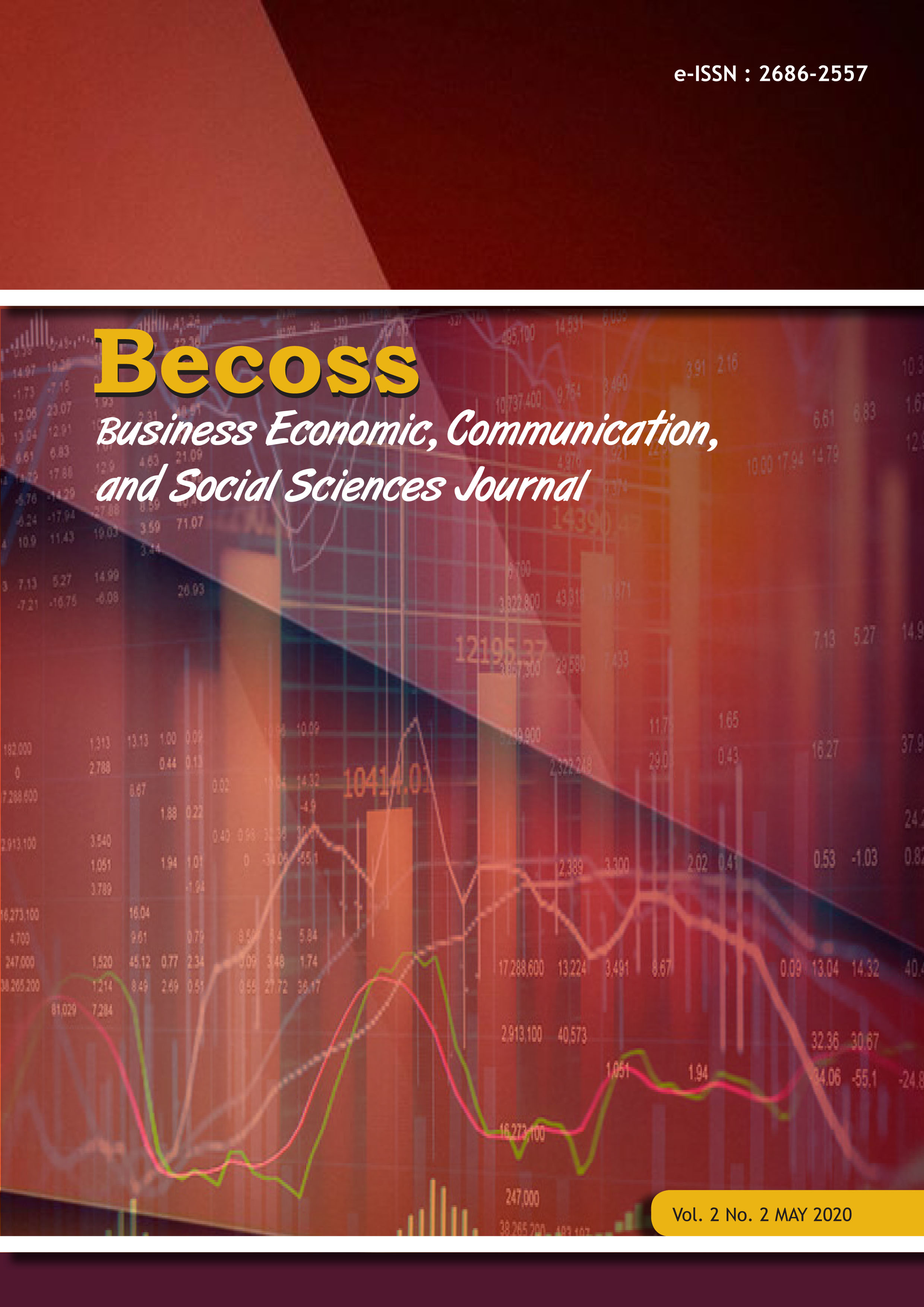Optimizing Access to Financial Capital of Creative Economy for Startups Towards Global Competitiveness
DOI:
https://doi.org/10.21512/becossjournal.v2i2.6246Keywords:
Non-banking capital access, startups, ecosystems, program strategiesAbstract
The lack of understanding of the financial capital of the creative economy regarding non-bank financial institutions limits the growth of Indonesia’s creative economy. Strategies through policies, capital owners, creative economy players and bring together capital owners with players. The capital of the creative economy is represented on the criteria: entrepreneurial characteristics, product/service characteristics, market characteristics, and financial characteristics. The method used is a qualitative analysis and quantitative analysis which starts from data collection, data analysis, participatory discussion, drawing conclusions, formulating policies and stakeholder synergy. The startup mentoring scoring instrument is a framework for investor’s decision making to invest in the startup. 3 scoring elements of mentoring startup scoring: Product & key person with a weight of 55%, Traction with a weight of 25%, and Investment with a weight of 20%. Primary data were obtained by participatory observation, field studies, and key informant interviews through startup mentoring programs, workshops, and startup competitions. Results: Among 20% of startups pitched in front of investors, there are 11% of startups that investors interested in and got funding from a consortium of Indonesian and foreign venture capital companies. Matchmaking activities increase added value, and the implemented policy also increases added value.References
Andra, Yudistira. (2016). Penanda-tanganan Perjanjian Kerja Sama Badan Ekonomi Kreatif (Bekraf) dengan Lembaga Pengelola Dana Bergulir - Koperasi dan Usaha Mikro, Kecil dan Menengah (LPDB - KUMKM).
Anon. (1969). 19-th Annual Book of ASTM Standards Part 17, ASTM, Philadelphia, p.636.
Arnold, Erik., Boekholt, Patries., Deiaco, Enrico., McKibbin, Shonie., Mothe, John de la., Paul, Simmonds., Stroya,James., & Zaman,Rapela. (2003). Research and Innovation Governance in Eight Countries: A Meta-Analysis. Work Funded by EZ (Netherlands) and RCN (Norway), Technopolis.
Bank Indonesia, Departemen Pengembangan UMKM. (2015). Kajian Peningkatan Akses Pembiayaan Bagi Industri Kreatif Di Indonesia Sektor.
Bappenas. (2008). Analisis dan Formulasi Kebijakan Pemanfaatan Sumber-Sumber Pendanaan Non-APBN.
Dian, Bernadheta. (2016). Bekraf Gandeng LKNB Tingkatkan Kualitas Pelaku Ekonomi Kreatif. http://www.harianjogja.com/Bekraf-Gandeng-LKNB-Tingkatkan-Kualitas-Pelaku. (Accessed in 10 December 2016).
Direktorat Akses Non Perbankan, Deputi Akses Permodalan, Badan Ekonomi Kreatif. (2017). Akses Permodalan, Tantangan & Telaah Strategi, ISBN 978-602-60735-0-1.
Hudson, & Evans. (2005). Journal of Economic and Social Policy. Vol. 10 No. 3.
Imam, Saputro. (2016). Badan Ekonomi Kreatif Jembatani Pelaku Startup dengan Pemilik Modal.
J.J. Favier, D. Camel. (1986). Proceedings of the Eight International Conference on Crystal Growth, York, U.K., p. 50.
L. Weiss. (1999). Instruction to Authors, Elsevier Publishing, http://www.elsevier.com/authors.html. (Accessed in 1 Januari 2000).
Lestari, Sri. (2016). Bekraf Pertemukan “Startup†dan Investor dalam “Startup Pitch Day†di Bali.
Mimi, Zulaikha. (2016). Dongkrak Investasi untuk Startup Indonesia, Bekraf Gelar Startup Pitch Day.
Nainggolan Ferry. (2016). BEKRAF Kerjasama Dengan Startup World Cup 2017.
Nicholson, R.D. (1980). International Structures In Nickelbased Transitions Joints After Long Term Service, Report RD/M/N1131, Central Electricity Generating Board, Marchwood.
Ramos, R. (1992).Thesis, College van Dekanen, University of Twente, The Netherland.
Sze. S.M. (1981). The Physics of Semiconductor Devices, Wiley, New York, p.245.
World Economic Forum. (2016). Acknowledgement.
Yamagishi,H., Hiroe,A., Nishio,H., Miki,K., Tsuge,K., & Tawada,Y. (1993). U.S. Patent No. 5264710.
Yud. (2016). Bekraf-Kinara Indonesia Gelar Startup Pitch Day.
Downloads
Published
How to Cite
Issue
Section
License
Authors who publish with this journal agree to the following terms:
- Authors retain copyright and grant the journal right of first publication with the work simultaneously licensed under a Creative Commons Attribution License - Share Alike that allows others to share the work with an acknowledgment of the work's authorship and initial publication in this journal.
- Authors are able to enter into separate, additional contractual arrangements for the non-exclusive distribution of the journal's published version of the work (e.g., post it to an institutional repository or publish it in a book), with an acknowledgment of its initial publication in this journal.
- Authors are permitted and encouraged to post their work online (e.g., in institutional repositories or on their website) prior to and during the submission process, as it can lead to productive exchanges, as well as earlier and greater citation of published work.
USER RIGHTS
All articles published Open Access will be immediately and permanently free for everyone to read and download. We are continuously working with our author communities to select the best choice of license options, currently being defined for this journal as follows: Creative Commons Attribution-Share Alike (CC BY-SA)






